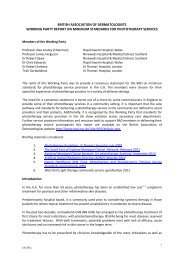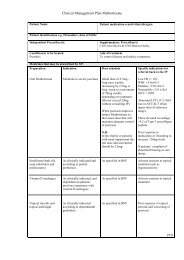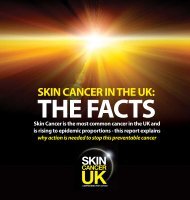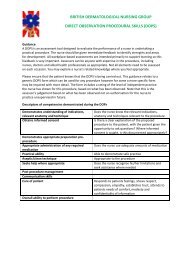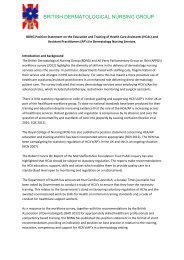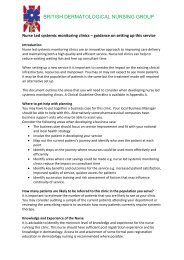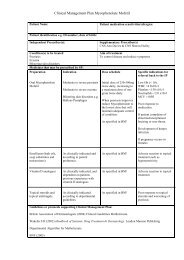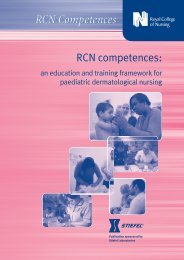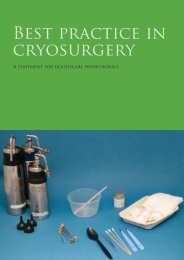Improving outcomes for people with skin tumours including melanoma
Improving outcomes for people with skin tumours including melanoma
Improving outcomes for people with skin tumours including melanoma
You also want an ePaper? Increase the reach of your titles
YUMPU automatically turns print PDFs into web optimized ePapers that Google loves.
<strong>Improving</strong> Outcomes <strong>for</strong><br />
People <strong>with</strong> Skin Tumours<br />
<strong>including</strong> Melanoma<br />
Appendix 4<br />
The identification and retrieval of evidence to support the<br />
recommendations in the guidance is described in detail in the<br />
Evidence Review. Briefly, there were three stages to this process:<br />
• Clinical question development. Members of the GDG were asked<br />
to submit clinical questions to the NCC-C on issues covered by<br />
the project scope.<br />
• Literature searching. All clinical questions were prioritised and<br />
were subject to either a systematic or a ‘high-level’ search.<br />
• Critical appraisal. Finally all full papers relevant to each clinical<br />
question were appraised using the methodology described in<br />
the NICE Guideline Development Methods manual.<br />
A4<br />
It should be noted that most of the published research on cancer<br />
topics focuses on clinical evaluations of treatment; little direct<br />
research has been carried out on the organisation and delivery of<br />
services.<br />
In order to elicit the views of patients <strong>with</strong> <strong>skin</strong> <strong>tumours</strong> on current<br />
cancer service provision, a piece of research was commissioned by<br />
the GDG and NCC-C. Researchers at the Department of Social<br />
Medicine, University of Bristol, per<strong>for</strong>med this study, the full results<br />
of which are given in the Evidence Review.<br />
All the evidence reviews used to in<strong>for</strong>m the manual are summarised<br />
in the document <strong>Improving</strong> Outcomes <strong>for</strong> People <strong>with</strong> Skin Tumours<br />
<strong>including</strong> Melanoma: the Research Evidence, which includes details of<br />
all the studies appraised. This document is available on a CD-ROM, a<br />
copy of which is included on the inside cover of the manual.<br />
Additional complementary research, designed to quantify the potential<br />
cost of major changes in services, was carried out by the Centre <strong>for</strong><br />
Economics and Policy in Health, Institute of Medical and Social Care<br />
Research (IMSCAR), at the University of Bangor. This work involves<br />
literature-searching, interviews <strong>with</strong> clinicians and managers, and<br />
analyses of costs.<br />
The writing of the guidance manual was coordinated by the Chair<br />
and Clinical Lead of the GDG in accordance <strong>with</strong> all members of the<br />
GDG, assisted by Dr Fergus Macbeth, Dr Andrew Champion and Dr<br />
Mary Webb at the NCC-C.<br />
The production of this guidance was funded by the National Institute<br />
<strong>for</strong> Health and Clinical Excellence (NICE), and has been subject to<br />
the full NICE consultation process.<br />
142<br />
National Institute <strong>for</strong> Health and Clinical Excellence




